Table of Contents
Kettlebell – an iron ball with a handle which you will find in almost every fitness centre. Although it does not look like a traditional barbell at first glance, almost everyone knows what it is used for. Well, perhaps except from your grandparents, unless they’re one of “the modern crossfiters” and lift more weight than you. If not, they would probably consider the kettlebell to be a large paperweight or a weight for an antique scale. You may have thought that it is a modern exercise accessory invented by some brilliant fitness marketing “guru” after 2000, when kettlebell workout became a huge trend in the world. But the opposite is true. Training with a similarly looking weight was probably already used by the ancient Greeks in their preparation for the first Olympics. In ancient times, Shaolin monks probably also got in shape thanks to stone blocks with holes for grip.
In modern history, most sources agree that the Kettlebell “boom” has its roots in Russia. During the 19th century, Dr. Vladislav Kraevsky began promoting this accessory, then called “Girya”. He began using it in sports medicine and then in the physical training of Russian soldiers. The popularity of kettlebell workout in Russia has grown to the point, where this type of workout is a part of their culture. This easy-to-grip piece of iron became popular in training centres in the USA at the beginning of the 21st century, probably thanks to the Belarusian trainer Pavel Tsatsouline who back then trained soldiers of Soviet special forces, and after emigrating to the USA, also members of United States Marine Corps. Exercise with kettlebell has gradually spread from the United States around the world, so we can enjoy it or hate it as a part of our training as well. [1-2]
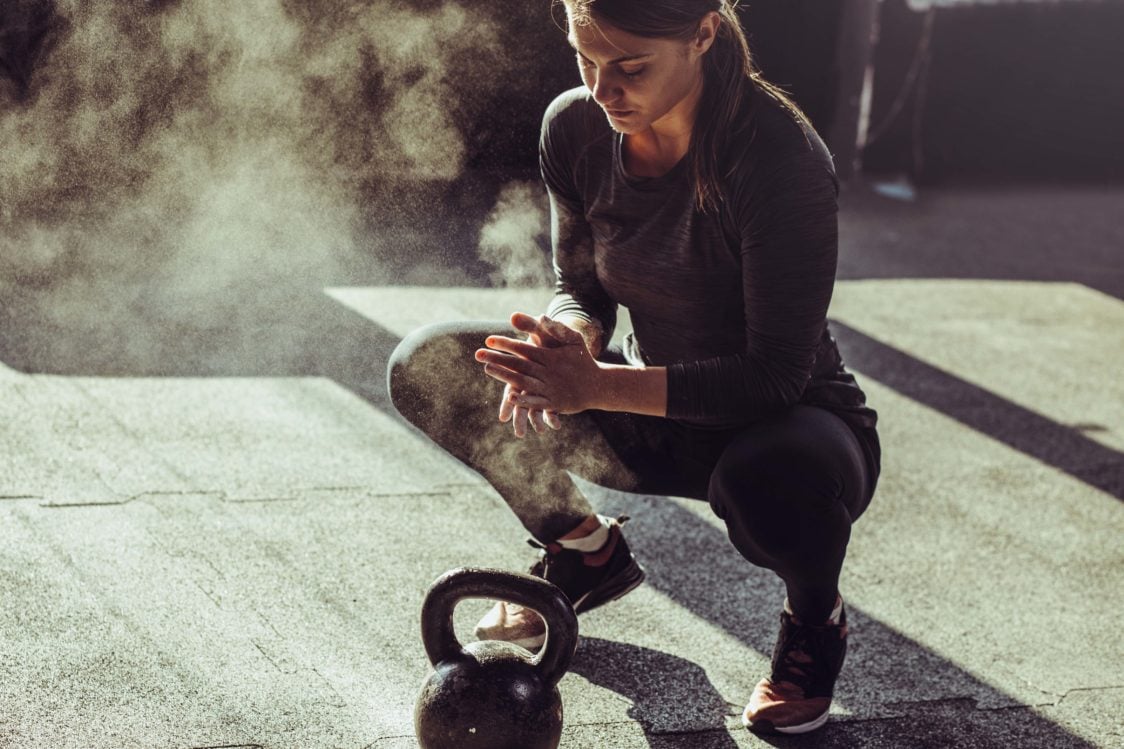
10 Advatages of Exercise with Kettlebell
Not only will you feel like the biggest “hard worker” far and wide when exercising with the iron ball, the kettlebell will also bring a new dimension of fun to your training, but also hard work which will soon pay off in the form of great results.
In order not to waste your hard work when trying to lose weight or gain muscle, it is also important to adjust your diet and respect energy balance. If you are interested in more information on how to improve your diet, read our article A Simple Guide on How to Count Calories and Achieve Your Goals.
1. You may use it during your strength training or HIIT workout
You can include kettlebell exercises in almost all your favourite workouts. Crossfitters who are not even afraid to run with a kettlebell would certainly tell you that you can do almost anything with it. That’s not what you have to do, of course. You can include kettlebell goblet squats in your strength training, while kettlebell lunges may find their place in your intensive HIIT workout, for example. [3]
If you haven’t heard of HIIT workout yet and want to learn more about it, read our article 6 Reasons to Try High Intensity Interval Training (HIIT) and Its Training Plan.
2. You can target your whole body with it
You can target the muscles of your legs, booty, abdomen, back, shoulders, arms, but also your chest and arms with the kettlebell. You can use it instead of a classic barbell for almost all exercises. We will show you the particular exercises later on in the text.
3. It is ideal for complex multi-joint exersices
Not only will you work all the muscles of the body with it, but you can engage several body parts at once in one exercise. For example, Turkish get up with the kettlebell brings your “complex exercise” to a whole new dimension, since you involve both the lower and upper body while your core is engaged during the whole time.
You might be interested in these products:
4. You will improve your strength, endurance and joint mobility
By using kettlebell for different types of training, you can improve in strength, endurance, and with the right technique, it is even possible to increase the range of motion in your hips or shoulders. Some kettlebell exercises, such as the Turkish get up or snatch, are rather difficult when it comes to mobility. By including them in your training, you can contribute to improving the range of motion and joint stability. You can benefit from it even in everyday life, since good mobility can protect you from unpleasant injuries due to an “awkward” fall, for example, [4]
5. You will support proper posture
When you use the kettlebell properly, and so you pay attention to technique and proper involvement of the core of the body, you can improve the stability of your spine and overall posture. This comes in handy not only during your training, but also in everyday life. In this way, you preventively fight against back pain, for example. [5-6] If you are interested in what can affect back pain, read our article 7 Tips on How to Outsmart Back Pain Caused by Long Periods of Sitting.
6. You can improve your grip
When exercising with kettlebell, you will also strengthen the muscles of your forearms, palms and fingers which can significantly improve the strength of your grip. This will pay off, for example, while doing pull-ups on a horizontal bar, during a heavy deadlift with an axle bar, or even on your way home from the shop with bags full of goods for the whole upcoming week. [7]
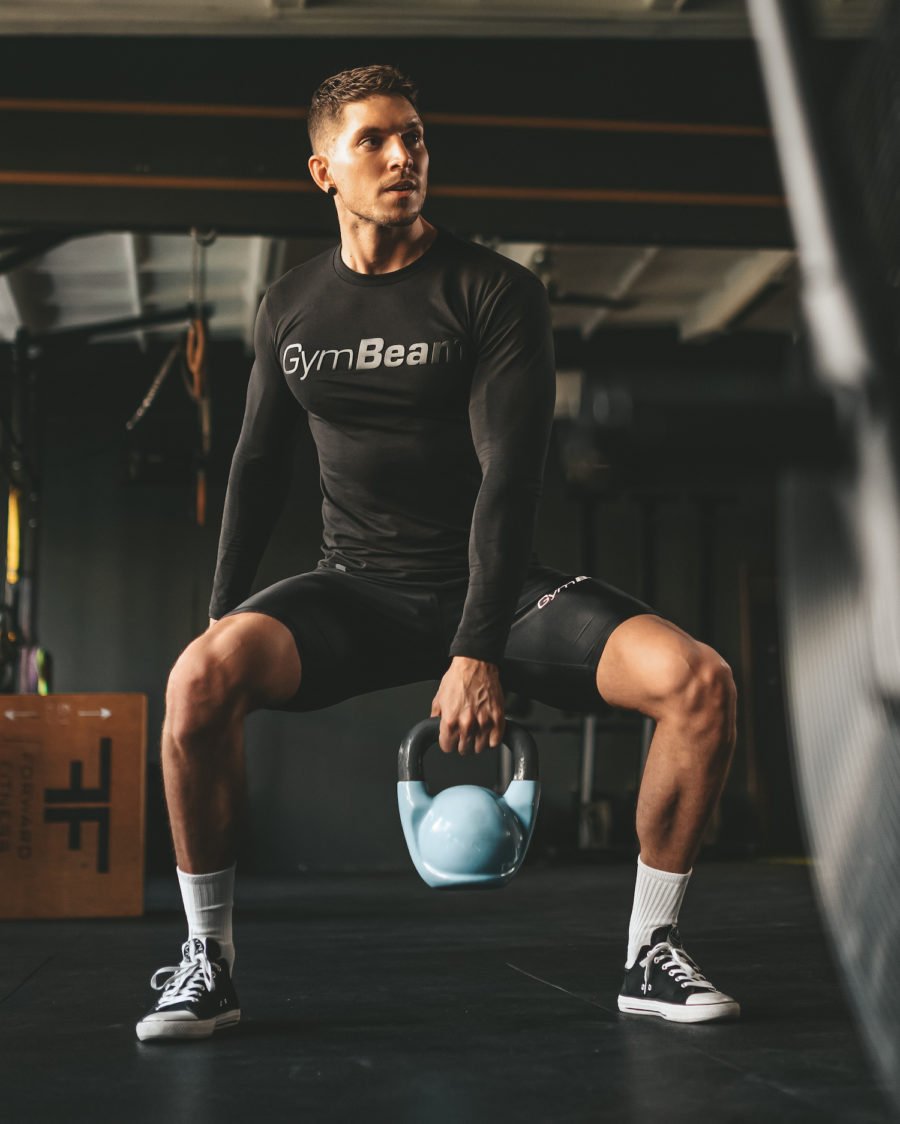
7. It can serve as a new impulse in your training
Do you need a change in your training routine? Then let the kettlebell become a part of your home gym and training plan. By doing that, you will discover new exercises, engage muscles that you have neglected by now, and you will avoid stereotyping in your training. You can read more about how to plan your workout, overcome training stagnation and lose weight in our article Can You Gain Muscle Faster, or Lose Weight with Muscle Confusion?
8. It will help you burn calories effectively
Exercising with the kettlebell is primarily a strength exercise, but when you increase the intensity of your training, it can easily become cardio. As a result, you will burn a significant number of calories not only during the training, but also after it because your muscles will need energy for their regeneration and growth.
It always depends on the specific training program and intensity, but for example, a woman with the weight of 60 kg can burn approx. 504 kcal in 60 minutes of intense kettlebell workout and a man with 80 kg about 672 kcal. These energy values correspond to a large portion of a lunch or dinner. [8]
Cardio or HIIT workout is often used to burn fat and calories as effectively as possible. If you are interested in which of these workouts is better for burning fat, read our article Classic Cardio or HIIT Workout – Which One Burns Fat Better?
9. It is compact
The kettlebell won’t take up much space at your home. You can hide it under the bed or in the corner of the room, even the tiniest one. Of course, it depends on how many will you buy, but kettlebells are likely to take up less space than exercise machines, classic dumbbells or an Olympic bar.
10. There are a lot of variations to choose from
If you are a beginner, a smaller weight of kettlebell (e.g. 4 and 8 kg) will suffice. If you exercise regularly, you will become stronger over time, and you can try training with a 12 or 16 kg ball. Furthermore, if you don’t like having several kettlebells with different weights, and you want to save space, then an adjustable kettlebell will be ideal for you, since it is suitable for both beginners as well as advanced sportsmen, as it offers a range from 4.5 to 18 kg.

8 Best Booty & Leg Exercises with Kettlebell
If exercising with a kettlebell is entirely new to you, start with a lower weight and pay close attention to the correct performance of the particular exercises. Once you are more confident with the exercise technique and the weight you are used to will no longer be such a challenge for you, feel free to start using a heavier kettlebell or add weights to the adjustable kettlebell.
Do not forget to warm up slightly before each workout, for example in the form of running on the spot, jumping jacks or dancing, then move onto the dynamic stretching, where you warm up all the large joints, such as knees or hips doing a circular motion, and after the main part, take a moment for static stretching. Do you want to learn more about stretching, its types and benefits? Then read our article Warming up, Stretching and Cooling Down – Are They Really Important?
All these exercises can also be performed with your own weight without the use of weights. By training large muscles such as those in the front and back of your thighs as well as your bottom, you will burn a lot of calories at the same time. The following exercises are complex, so you will also involve the core of the body, arm and back muscles, in addition to the primary muscles of the lower limbs.
1. Kettlebell Squats
Initial position: Wide stance a little less wide than your shoulder width. Take the kettlebell with your arms extended alongside the body. Your back should be straight, shoulders down, abs engaged and eyes to the front.
Performance: Do a squat with hips going back, the kettlebell may slightly touch the floor and come back to the initial position by contracting your thighs and glutes. Your arms remain in the same position throughout the whole exercise. Your knees are pointing outwards and your body weight is on the whole surface of your foot.
Common mistakes: Round or too bent back, knees pointing inwards, shoulders raised up towards the ears, body weight is distributed only on toes, excessive lean forwards, small range of movement.
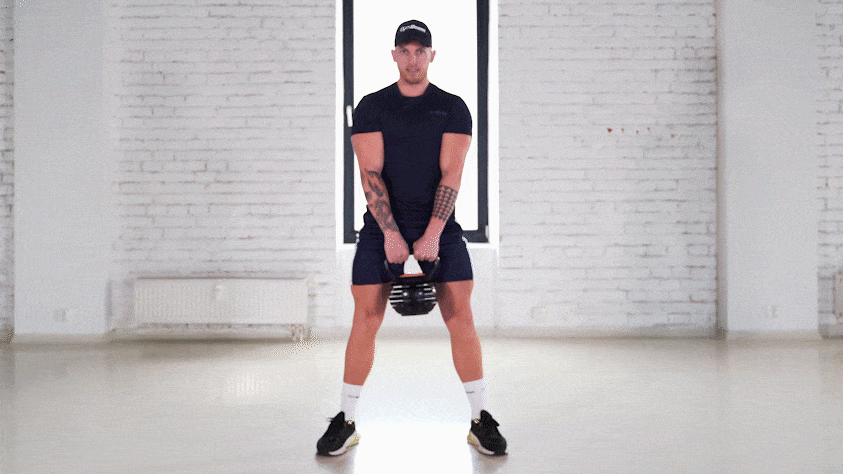
2. Kettlebell Deadlift
Initial position: Wide stance a little less wide than your shoulder width. Take the kettlebell with your both arms extended alongside the body. Your back should be straight, shoulders down, abs engaged and eyes to the front.
Performance: Get low with your hips going back and slightly bent knees. Your arms remain in the same position throughout the whole exercise. Come back up to the initial position by contracting your thighs and glutes. Your knees are pointing outwards and your body weight is on the whole surface of your foot.
Common mistakes: Round or too bent back, knees pointing inwards, shoulders raised up towards the ears, body weight is distributed only on toes, excessive lean forwards, small range of movement.
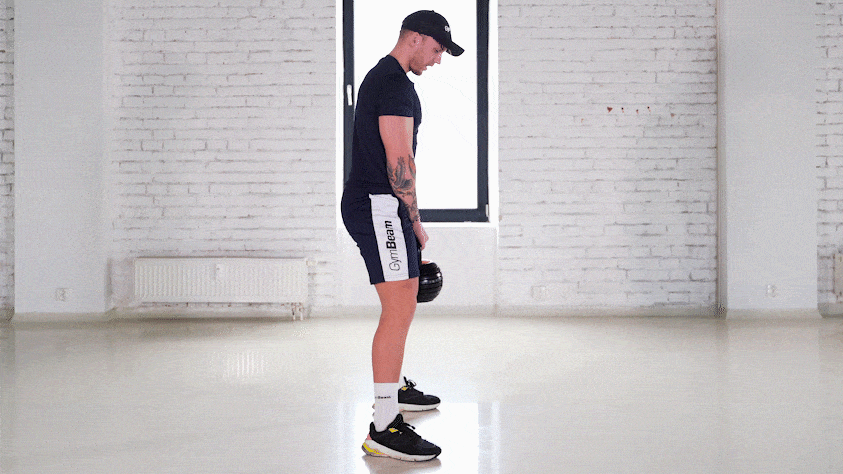
3. Kettlebell Reverse Lunges
Initial position: Moderate wide stance. Hold the kettlebell by the side of the handle with both hands and keep it in the position close to your chest by bending your arms in the elbows. Your back should be straight, shoulders down, abs engaged and eyes to the front.
Performance: Do a lunge by extending one leg backwards and bending the knee of your other leg. Your back knee may slightly touch the floor. Come back to the initial position by activating your thighs and glutes. Do the same motion with your other leg. Your body weight is on the whole surface of your foot.
Common mistakes: Round or too bent back, shoulders raised up towards the ears, excessive lean forwards, small range of movement, knee is not along with the toe.
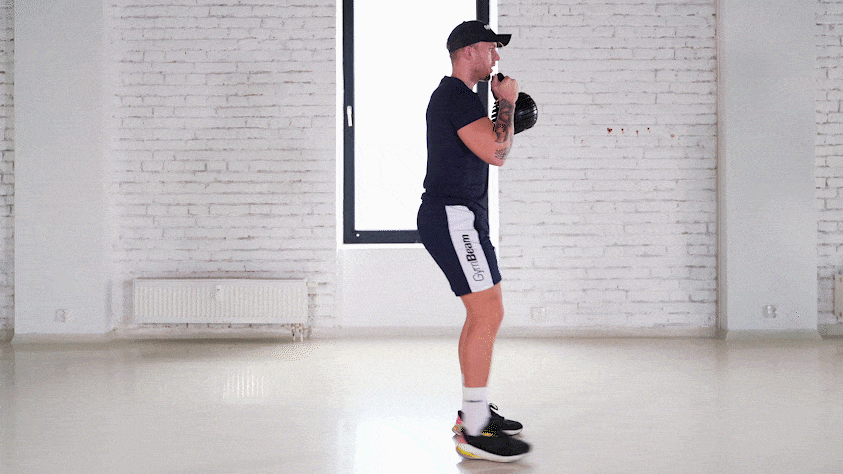
4. Kettlebell Side Lunges
Initial position: Moderate wide stance. Hold the kettlebell by the side of the handle with both hands and keep it in the position close to your chest by bending your arms in the elbows. The knee of the working leg is pointing outwards while bending. Your back should be straight, shoulders down, abs engaged and eyes to the front.
Performance: Do a side lunge by stepping to the side and bending the knee of one leg. The other leg remains extended. Come back to the initial position by activating your glutes and thighs. Do the same motion with your other leg. Your body weight is on the whole surface of your foot.
Common mistakes: Round or too bent back, shoulders raised up towards the ears, the knee of the active leg is pointing inwards while bending, small range of movement.
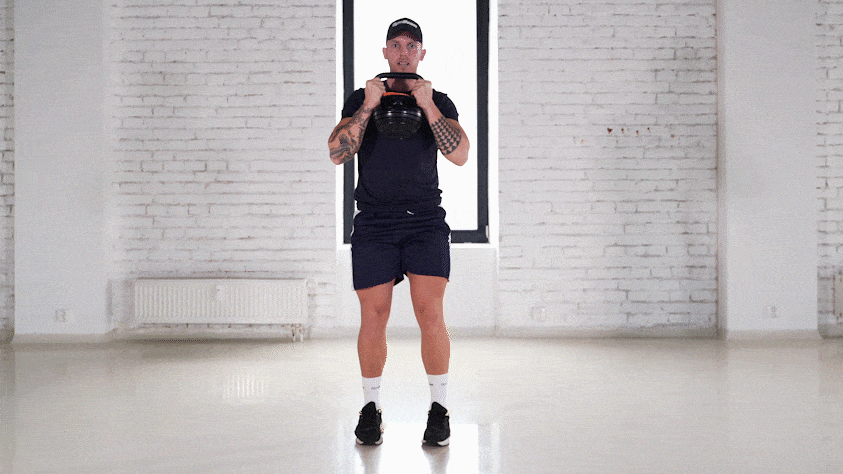
5. Kettlebell Jump Squat
Initial position: Wide stance a little less wide than your shoulder width. Take the kettlebell with both arms extended alongside your body. Your back should be straight, shoulders down, abs engaged and eyes to the front.
Performance: Do a squat with your hips going back and jump by contracting your thighs, glutes and calves, so your feet come off the ground. Then come back to the squat position. Your arms remain in the same position throughout the whole exercise. Your knees are pointing outwards.
Common mistakes: Round or too bent back, knees pointing inwards, shoulders raised up towards the ears, excessive lean forwards, small range of movement.
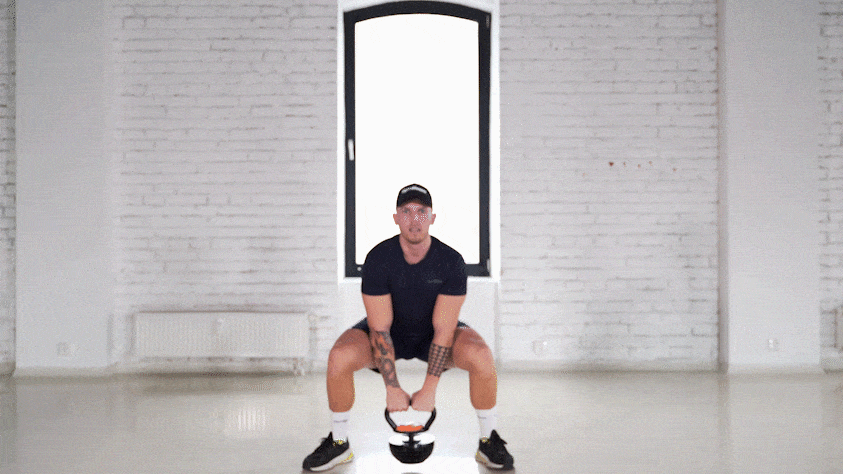
6. Kettlebell Reverse Jump Lunges
Initial position: Moderate wide stance. Hold the kettlebell by the side of the handle with both hands and keep it in the position close to your chest by bending your arms in the elbows. Your back should be straight, shoulders down, abs engaged and eyes to the front.
Performance: Do a lunge by extending one leg backwards and bending the knee of your other leg. Your back knee may slightly touch the floor. Come back to the initial position by activating your thighs, glutes and calves and change your legs.
Common mistakes: Round or too bent back, shoulders raised up towards the ears, small range of movement.
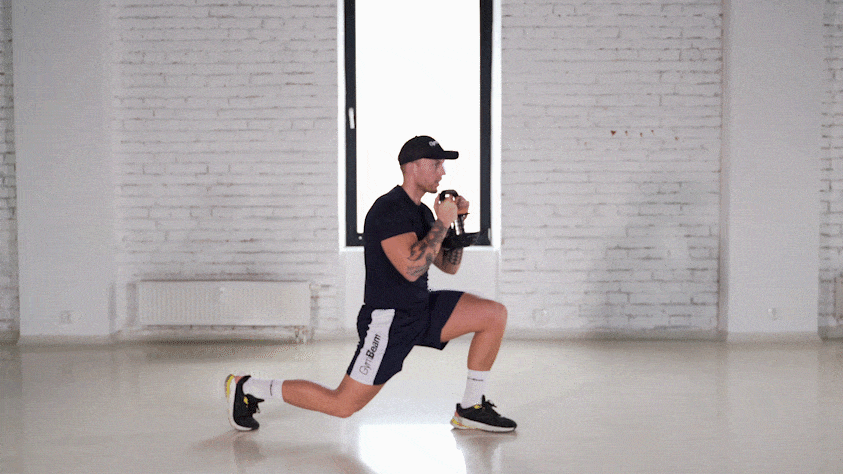
Easier variation with biceps curl
You can replace jump reverse lunges with this variation. By doing so, you will also engage your biceps.
Initial position: Moderate wide stance. Hold the kettlebell by the side of the handle with both hands. Your back should be straight, shoulders down, abs engaged and eyes to the front.
Performance: Do a lunge by extending one leg backwards and bending the knee of your other leg. Your back knee may slightly touch the floor. Come back to the initial position by activating your thighs, glutes and calves and change your legs. Simultaneously, bend your arms in the elbows when going down and back and do the biceps curl. Extend your arms again on your way up. Your elbows remain in the same position close to your body while bending – they do not aim outwards nor outwards.
Common mistakes: Round or too bent back, shoulders raised up towards the ears, elbows pointing out from the body while bending, small range of movement.
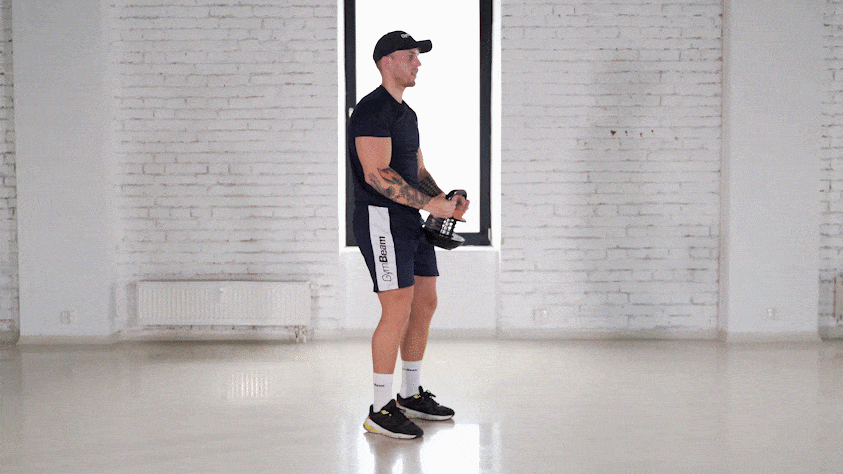
7. Kettlebell Romanian One Leg Deadlift
Initial position: Wide stance a little less wide than your shoulder width. Take the kettlebell with one arm extended alongside your body. Your back should be straight, shoulders down, abs engaged and eyes to the front.
Performance: First do the exercise with one leg, then change your legs. Hold the kettlebell in your right hand and extend the left stretched leg backwards and lean forward at the same time. It is not necessary to touch the ground with the kettlebell, the most important is to maintain your back straight and legs just slightly bent in the knees. Your arms remain in the same position throughout the whole exercise. Come back to the initial position by contracting your thigh and glute muscles and repeat the motion. The motion should be continuous and controlled.
Common mistakes: Round or too bent back, shoulders raised up towards the ears, lean to the sides during the movement, excessive hip lean forward in the upper position, excessive bend in the knee, small range of movement.
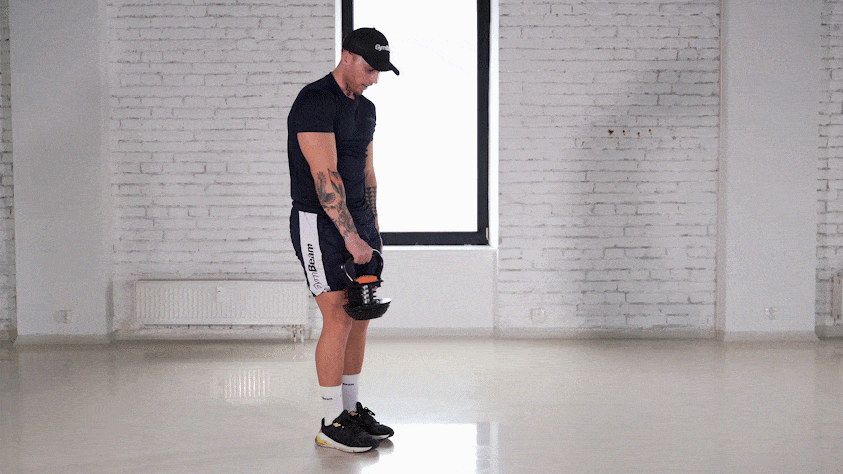
8. Kettlebell Plank + Deadlift
In addition, you will also involve the core of the body and arms with this exercise, except from the muscles of the lower limbs.
Initial position: Wide stance a little less wide than your shoulder width. Take the kettlebell with your both arms extended alongside the body. Your abs are engaged throughout the whole exercise and eyes are to the front.
Performance: Get to the lower position by pushing your hips back and slightly bending your knees. Your arms remain extended during the whole time. Put the kettlebell on the ground in the lower position, shift your weight to your upper limbs and dynamically extend your both legs backwards. Maintain your back straight during the deadlift as well as the plank position.
Common mistakes: Round or too bent back during deadlift and plank position, shoulders raised up towards the ears, knees pointing inwards, body weight is on one’s toes during the deadlift, excessive lean forward in the upper position, small range of movement.
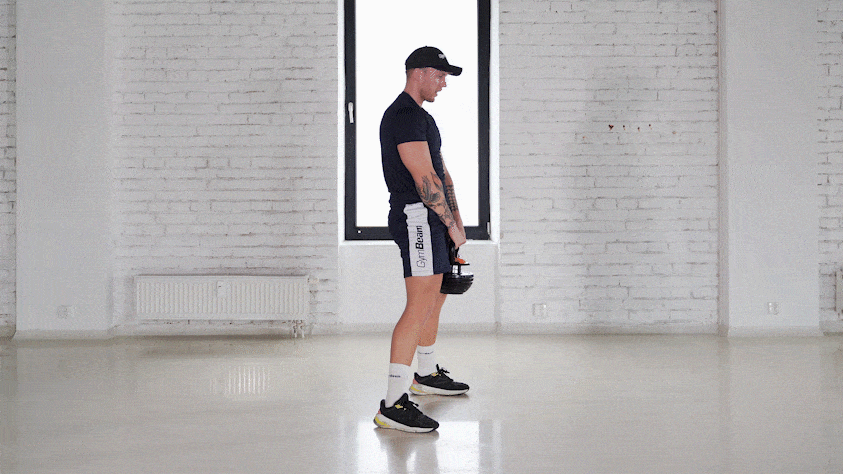
You will also find some inspiration for kettlebell workout in the video: Kettlebell Exercises for Effective Muscle Growth
How to include these exercises into your workout?
Since these are quite intensive and energetic exercises, it is not the best idea to include them all in one workout. You can include them gradually into your workouts during the week. For example, do some in your full-body workout, include the other in the HIIT workout and leave the rest for strength training of the lower body. It is also important to think about the distribution of exercises within one training unit. This means that you include the most difficult exercises, such as squats and lunges, right at the beginning, when you have the most energy.
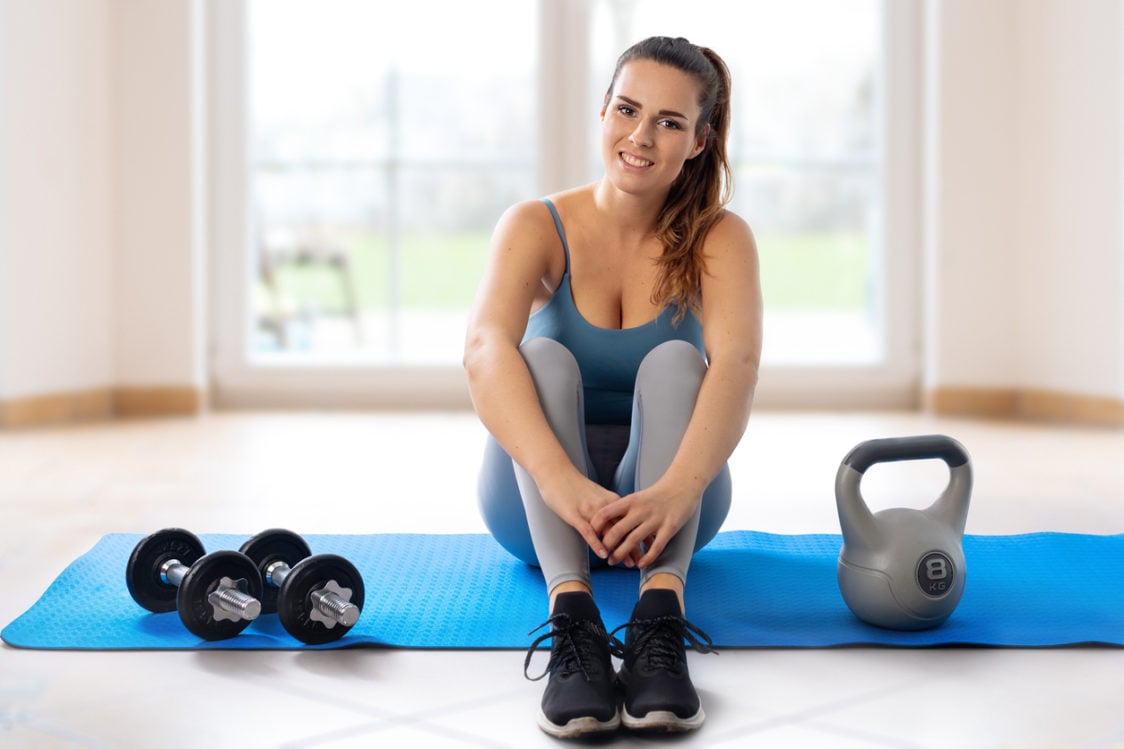
If you work out at home, and you want to create your own training plan, you should not miss our article How to Build a Proper Training Program for Home Workouts? And if you want to kill your home workout, you can be inspired in our article How to Make Your Home Workout More Challenging Even Without Fitness Accessories.
Before you start training, don’t forget to warm up thoroughly and prepare your body and mind for the upcoming performance. You can do some jumping jacks, dance to your favourite song or make a few burpees. Then warm up the large joints of your whole body doing a circular motion, as you were taught in physical education classes, and you can feel free to dive into the main part. You can include this training focused on the lower body twice a week. The number of repetitions is up to you, but always follow your own feelings, so that your muscles already “burn” properly by the end of the set, and you can work out until your muscles are exhausted. After finishing the main part, take a moment to cool down and stretch lightly by doing some static stretching.
Table with an example of training – choose the weight yourself
| Exercise | Number of repetitions | Number of series | break between the series |
|---|---|---|---|
| Kettlebell Jump Squat | 8–12 | 3–4 | 1–2 min. |
| Kettlebell Reverse Lunges | 10–16 | 3–4 | 1–2 min. |
| Kettlebell Deadlift | 8–15 | 3–4 | 1–2 min. |
| Kettlebell Squats | 8–15 | 3–4 | 1–2 min. |
| Kettlebell Romanian One Leg Deadlift | 8–12, one leg, then the other leg | 3–4 | 1–2 min. |
What should you remeber?
An iron ball with a handle has been helping humanity improve physical condition and constitution for many years. Exercising with a kettlebell has many benefits. You will use it in almost every workout of yours, you will strengthen the whole body and some exercises will bring to fire almost all the muscles of your body at once. In the article, you got to know 8 very effective exercises which will help you achieve round bottom and strong legs. At the same time, you will burn a large number of calories and improve your condition and mobility.
Do you know all these exercises? Are you planning to try out the training? Share your experience with us in the comments, and if you liked the article, you can share it with your friends so that they can learn about the benefits of kettlebell workout as well.
[1] Kettlebell World. Kettlebell Origins and History, from 700 bc to World Domination. – http://kettlebellworld.co.uk/kettlebell-history/
[2] Nguyen, T. C. Who Invented the Kettlebell? – https://www.thoughtco.com/who-invented-the-kettlebell-4038483
[3] Precision Nutrition. All About Kettlebells.– https://www.precisionnutrition.com/all-about-kettlebells
[4] Falatic, J. A., Plato, P. A., Holder, C., Finch, D., Han, K., & Cisar, C. J. Effects of Kettlebell Training on Aerobic Capacity. – https://doi.org/10.1519/JSC.0000000000000845
[5] Jay, K., Jakobsen, M. D., Sundstrup, E., Skotte, J. H., Jørgensen, M. B., Andersen, C. H., Pedersen, M. T., & Andersen, L. L. Effects of kettlebell training on postural coordination and jump performance: A randomized controlled trial. – https://doi.org/10.1519/JSC.0b013e318267a1aa
[6] Sportsinjuryclinic.Net. 5 Great Benefits of Kettlebell Training. – https://www.sportsinjuryclinic.net/sport-injuries/sports-injury-prevention/5-benefits-kettle-bell
[7] SET FOR SET.18 Incredible Benefits of Kettlebells. – https://www.setforset.com/blogs/news/18-benefits-of-kettlebells
[8] Ainsworth, B. E., Haskell, W. L., Leon, A. S., Jacobs, D. R., Montoye, H. J., Sallis, J. F., & Paffenbarger, R. S. (1993). Compendium of physical activities: Classification of energy costs of human physical activities. – https://doi.org/10.1249/00005768-199301000-00011


Add a comment